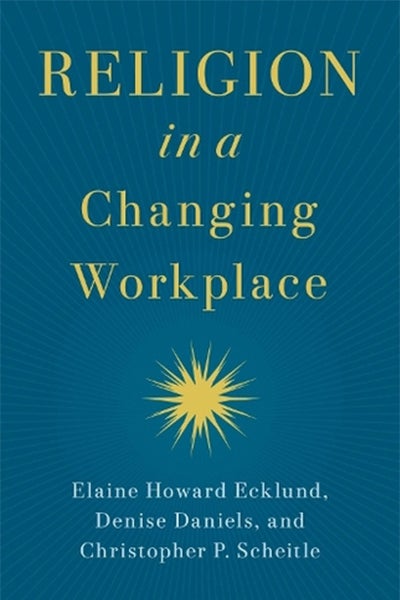Reviewed by Akpan Ubong-Abasi, Department of Religion

Religion in a Changing Workplace, by Elaine Howard Ecklund, Denise Daniels, and Chris Scheitle draws on five years of data to investigate the role of religion in United States workplaces. Survey data was conducted with more than fifteen-thousand US adults, personal interviews and focus groups, as well as one-on-one conversations wtih hundreds of people. The research was conducted during a time of significant events in the United States, including the COVID-19 pandemic, which had a profound impact on how people relate to their jobs.
In brief, while faith and spirituality are increasingly important to employees and can positively impact in the workplace, their expression of faith at work must be navigated thoughtfully to avoid marginalization and discrimination. This requires organizations to develop inclusive policies and practices for the expression of faith at workplaces to model a sense of pluralism.
The authors argue that religion can be integrated into the workplace in advantageous ways. In challenging the secular vs private religious identity paradigms, the book argues that workplace environments can foster broader inclusivity and pluralism. In proffering solutions, the authors discuss useful strategies organization leaders can utilize to support religious expressions at workplaces, as well as protecting and respecting the identities of all religious and non-religious identities. The strategy model is twofold: helping religious employees identify ways to express their faith without violating laws or company policies, and secondly, recognizing the ways individuals and groups experience religious discrimination in the workplace and implementing policies to mitigate it.
The ten chapters offer a nuanced perspective on the expression of faith in US workplaces, bringing to the fore positive and sometimes complicated outcomes. Bringing faith to work is helpful for reducing burnout, improving productivity and happiness, working better with others, and increasing conflict resolution. On the other hand, complication arises from the diverse nature of religion and the increasing religious, racial, and ethnic diversity in US workplaces. Welcoming faith into the workplace can cause marginalization and make colleagues who do not share the majority's faith perspective uncomfortable and discriminated against.
In conclusion, the authors want readers to consider religion as a form of workplace diversity that can, under certain conditions, create positive outcomes; to learn about how much religious diversity there is in workplaces and organizations and to create pathways for engaging this diversity. This is particularly important as the workplace is one of the only places where individuals get to meet people of different religions.
While the data is collected from a cross-section of the contemporary US economy workforce, the exclusion of the historical trajectories of religion and labor to ground the narratives is a drawback. Despite this exclusion, the book is insightful and an easy-to-read text. I recommend the book to policymakers, employers, employees, and mangers interested in learning about integrating religion in the workplace. The book is a great resource for sociologists, religious studies, and scholars of organization and management.
Ecklund, Elaine Howard, Denise Daniels, and Christopher P. Scheitle, Religion in a Changing Workplace. New York: Oxford University Press, 2024.

